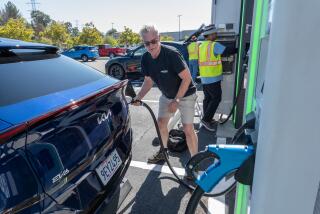Getting the best deal on an auto lease
- Share via
Auto leasing deals abound these days, with offers that often seem too good to be true.
How about a well-equipped Honda Accord for $250 a month with no down payment or any other drive-off fees? Or better yet, $199 a month for a Chevrolet Malibu?
So, what’s the catch? There isn’t any if you know what you’re getting into.
There are always details. You need top-tier credit to qualify. You pay a penalty if you turn that Honda in with more than 36,000 miles. And the payment is not $250 a month because of that little matter of tax. It is more like $275, depending on where you live.
After driving into a ditch during the recession, auto leasing is back in a big way, with Toyota, Honda and others all battling for customers with enticing lease offerings.
But to get the best deal you need to learn the arcane art of the lease transaction. There’s complicated lingo to understand and some basic steps to take.
Leasing can get you into a new car for less upfront money, but remember this: It is a long-term rental contract, not a purchase. At the end of the lease, you hand the keys back to the dealer and walk away, regardless of how much money you put into monthly payments and upkeep.
Before stepping into a showroom, get a good idea of how much you drive annually. Leases aren’t for people who pile up the miles because they typically limit the use of a car to an average of 10,000 to 12,000 miles a year for the term of the contract. You will pay penalties if you turn in the car with more miles than allowed.
Now determine whether you are an auto flipper who yearns for the next hot vehicle about the time the new-car smell fades or you are the practical sort who puts 150,000 miles on a car even if the dashboard vinyl is cracked.
Beverly Rumfola of Whittier has leased her last three autos because “I like having a new car and I like having it always under warranty. Financially, it is better to buy a car and keep it for 10 years, but this works for us.”
A customer service manager for a chemical company, Rumfola recently took advantage of Honda’s specials to lease a new four-wheel-drive Accord Crosstour crossover vehicle to replace a Cadillac SRX that had reached the end of its lease term.
“It has room for the dogs and plenty of seating room,” Rumfola said of her new ride. “It sits higher than a regular sedan. I really love it.”
At the other end of the spectrum is Michael Pranivong, a computer programmer from Fort Worth, Texas, who recently decided against a lease after checking out deals for a new Lexus IS 250 sports sedan he was looking at to replace his 1999 BMW 328, which has 145,000 miles on the odometer.
With a lease, “you really have to watch your miles,” Pranivong said. And he was concerned about charges he could incur if he put a lot of wear and tear on the car.
Next step for the prospective lessee: Decide what type of vehicle you want. Is it a luxury sports sedan like a BMW 5 series? A mid-size family vehicle such as the Ford Fusion? Or a practical, fuel-efficient transport and hauler such as the Honda Element?
Test-drive several vehicles in the class you are considering to determine what you like and how you would like it equipped. Read reviews at consumer-friendly publications and websites such as Consumer Reports, Edmunds.com and Kelley Blue Book to learn what the experts are saying.
Resist the urge to drive a car and immediately sign a contract. Patience and research can save you hundreds to thousands of dollars over the term of the lease.
Now that you have a target vehicle and its options, go to the manufacturer’s website and see if there are any special deals on the vehicle. Don’t waste time going back to the showroom.
From here there are two ways to go. The simplest is to use the advertised lease deal offered by the manufacturer and compare multiple dealers to see who might go lower. E-mail or call the Internet or fleet managers at four or five dealerships. They have more negotiating power than the typical salesperson and are used to dealing with buyers remotely.
For example, in the case of the Honda Accord, ask if they can do the deal for $250 a month, including taxes. That change would save you about $800 over the term of a three-year lease. And, if you talk down one dealer, take that offer and call or e-mail the others again to see if they’ll beat it. Be sure your list includes some high-volume dealers.
When all but one drops out, you probably have a good deal.
“It is the last vestiges of horse trading,” said Larry Katzke, an incentives manager at American Honda Motor Co.
When you compare bids make sure that the monthly payment, length of the lease, drive-off cost (if any) and number of miles allowed over the contract term are the same, said Philip Reed, senior consumer advice editor for Edmunds.com. Dealers should provide a worksheet with this information.
A change in any one of those variables means you are no longer comparing apples to apples, and that could cost you money, he said.
Experts say you can sometimes obtain a better lease by breaking the deal into its components and negotiating each point.
Start with the capitalized cost of the vehicle, which is simply the negotiated price of the car if you were to purchase it outright.
Edmunds.com, Kelley and TrueCar.com all are useful sites that can help you figure out the lowest price for the vehicle.
TrueCar.com just unveiled a tool that can help you get to the low price range quickly. Its website will generate a graph charting the price of closed sales transactions in your region for the model and trim level you want. A “lowest certified price” shows what several dealers have agreed to sell the vehicle for, plus taxes and registration fees. (This is operated by a company affiliated with TrueCar.com that manages sales referrals.)
A Southern California shopper looking at TrueCar.com would see an $18,552 offer for that Honda Accord, along with prices as much as $1,200 higher from other dealers. The car has a sticker price of $22,565.
Honda’s lease offer assumes a sales price, or capitalized cost, of $20,961. So, use the $18,552 as the starting point for negotiating the capitalized cost portion of your lease. Other dealers might not move all the way down, but some are likely to drop their price by a significant amount.
The next piece of the puzzle is what’s called the “money factor.” Jesse Toprak, an analyst at TrueCar.com, says that this is just a different way of expressing an interest rate and is “designed to confuse consumers.”
The money factor on this Honda deal is 0.00137. It seems pretty meaningless, but if you multiply it by 2,400 (this always works regardless of the number) you get 3.29%, or the true interest rate on the deal.
Now you know if that component of the transaction is competitive with what you might get from a bank or credit union and whether it is in line with your own credit rating. It never hurts to ask for a better rate. (In this instance, American Honda says lease customers must accept this money factor to take advantage of a popular option of having their first monthly payment waived.)
The next piece of the puzzle is listed in the lease as the residual value of the vehicle, an estimate of what the car will be worth at the end of the lease. New vehicles with high residual, or resale, values typically have lower lease payments than other autos in a similar price range.
Manufacturers will disclose the residual value in the lease offer, but it is usually stated as the dollar amount you can pay to purchase the car at the end of the contract. You have to convert it to a percentage of the sticker price to be able to compare to other offers. Honda says the Accord’s purchase option is $13,539, which translates to a 60% residual. Residuals vary depending on the lender funding the transaction.
Remember, you want the residual to be as high as possible and the capitalized cost and interest rate to be as low as possible.
Other factors that affect the contract include how much cash, if any, the manufacturer puts into the deal as an incentive, the size of any down payment you might make, the length of the lease and the miles allowed.
Edmunds.com has a handy lease calculator that lets you alter variables to see how different residual, money factor and capitalized cost numbers change the contract.
In any deal, make sure the contract includes gap insurance, which covers any difference in what an insurance company will pay out if a car is destroyed in an accident and the value the lease company has assigned to the vehicle. Many manufacturers automatically wrap that into the transaction, but you should never sign a contract without checking that it includes this coverage.
You also want to be sure you’re getting a closed-end lease. (The Honda contract says so upfront.) That means that if you return the car with normal wear and tear you can walk away with no further expenses, even if the vehicle’s resale value is below what was estimated at the time the contract was signed. Most dealers write closed-end leases, but still double-check.
Never lease a car for a period longer than its warranty. One of the advantages of leases is that you should never have to worry about having to pay for repairs beyond normal maintenance.
Finally, be sure to “keep verifying that everything is in fact as good as it seems to be,” said Reed of Edmunds.com. “It is very easy to be bamboozled.”







